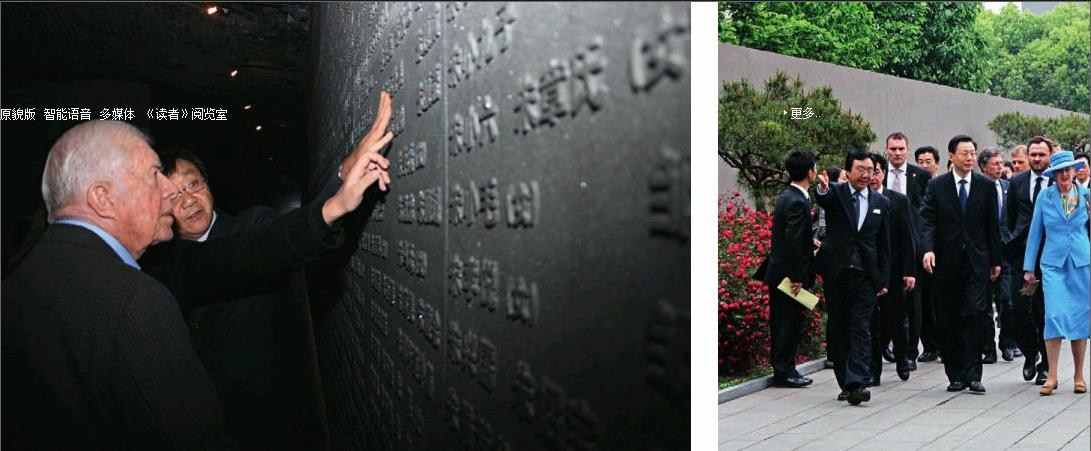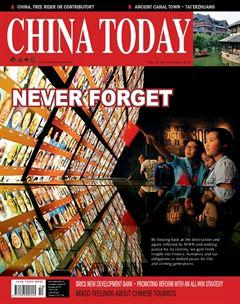Memorialize the Victims of the Nanjing Massacre
By+staff+reporter+AN+XINZHU


A Citys Memory
Eighty-five-year-old Xia Shuqin is one of the massacres survivors. On December 13, 1937, Japanese troops invaded Nanjing. Seven members of Xias family were killed on that day; eight year old Xia only survived because she fainted after being stabbed three times. Her familys tragedy was filmed by John G. Magee, an American priest and later chairman of the International Commission of the Red Cross in Nanjing. Over the following days one person was killed every 12 seconds. It was a nightmare for everyone in Nanjing.
On August 15, 1945, the Japanese Emperor broadcast the Imperial Rescript on the Termination of the War, marking Japans unconditional surrender and Chinas victory in the war of resistance. After the war, the International Military Tribunal for the Far East and Chinas Nanjing War Crimes Tribunal, one of the Allied War Crimes Courts, tried the Nanjing Massacre as a special case. Chinas Nanjing War Crimes Tri- bunal adjudged that the Japanese army had slaughtered more than 190,000 people on 28 separate occasions while murdering over 150,000 people in 858 episodic killings. The death toll exceeded 300,000.
However, the Japanese side continues to obfuscate history. In 1982, Japans Ministry of Education revised textbooks to replace the term “invasion” with“advance” to describe the war in China, earning the ire of the Nanjing public. On December 13, 1983, a monument was erected in Jiangdongmen, the site of mass executions and burials. In 1985, Nanjing opened the Memorial Hall of the Victims of the Nanjing Massacre by Japanese Invaders.
Zhu Chengshan has curated the memorial hall for 22 years. At that time, the memorial halls less than 100 exhibits and historical records were mainly limited to photographs. Zhu mobilized domestic and overseas support to collect more massacre-related objects. At the same time, construction began of a memorial wall engraved with the victimsnames. Zhu also launched oral surveys of seniors above 70 years old to collect survivors testimony.
While Zhu endeavors to save the citys memory, Japanese right wingers continue to deny the facts of the Nanjing Massacre. Xia Shuqin decided to stand up in defense of the truth. At the invitation of a Japanese non-governmental organization, Xia Shuqin and Zhu Chengshan visited Japan in August 1994 to expose the truth of the slaughter. In Hiroshima and Nagasaki, they attended memorials for the victims of atomic bombs in 1945. The largest rally attracted over 100,000 people. Participants included core leaders of the state and major parties. Japans Prime Minister also delivered a short speech.
“I had mixed feelings about it,” Zhu said. “The Japanese were paying their respects to war victims. But in China, we had never held any form of ceremony to mark the anniversary of the massacre.”After returning from Japan, Zhu Chengshan proposed memorial events for the victims of the massacre in Nanjing.
On December 13, 1994, the first-ever commemorative event was held in Nanjing. Representatives from all walks of life attended the ceremony in the memorial hall and released peace doves. An air-raid siren wailed across the city.
In the following years, commemorations grew to include peace rallies, wreath-laying, tolling of bells and the presentation of a peace declaration.
A Bond for History and Peace
The Memorial Hall of the Victims of the Nanjing Massacre by Japanese Invaders is an important platform for commemorative activities. Having been expanded several times, the memorial hall now occupies a gross area of 7.4 hectares with floor space of 25,000 square meters. It houses over 150,000 exhibits and receives more than six million visitors per year. Over 10,000 victims names are carved on the memorial wall.
In addition, the memorial hall is a bond for promoting peaceful interactions between China and the world. It has held exhibitions in more than 50 foreign cities and arranged for survivors to give testimony in Japan, making a significant contribution to proving historical facts and passing down historical memory.
Over the past 29 years, Japans Japan-China Society has organized annual visits to China to plant trees in Nanjing. This practice is called “green atonement.” Other Japanese peace organizations attend peace rallies in Nanjing annually.
Visitors to the memorial hall have also left countless moving messages.“This is testimony to the horrors of war and the need for peace in all nations,”wrote former U.S. president Jimmy Carter. Visitors from Japan are impressed by the exhibitions as well. After visiting the memorial hall on December 13, 2013, Takaiane Yasunori, a professor from University of Nagasaki, said, “I am shocked by all of the photos exhibited here. In the past, I always heard how Japan had been hurt by that war, but this is not the whole story. Japanese people need to know that Japan was the aggressor during WWII, and more importantly, they need to know about Japans cruel crimes against the Chinese people.”
Remember, but not to Hate
Although many Japanese are penitent about the Nanjing Massacre, some people in Japan still refuse to acknowledge it. Revisionists claim that it “probably never happened” or that it is “the biggest lie of the 20th century.”
In 1998, Shudo Higashinakano, an Asia University scholar, defamed Xia Shuqin in Complete Investigation into the Nanjing Massacre by saying that Xia had fabricated her story. The book stung Xia Shuqin, who sued Shudo Higashinakano for defamation. Zhu Chengshan submitted his testimony in support of Xia to the local court of Tokyo and traveled to Japan with Xia to handle the case. Seven years later, a Tokyo court gave a judgement in Xias favor and ordered compensation of RMB 260,000.
During this time, the curator was striving to set December 13 as Chinas National Memorial Day. His proposal was submitted to the state authorities by deputies to the National Peoples Congress (NPC) and members of the National Committee of the Chinese Peoples Political Consultative Conference(CPPCC). It soon received wide support from the public.
“The survivors are of advanced age. We have lost many of them in the last few years. Only around 100 are still living. To Xia Shuqin, winning the lawsuit has caused more accusations from Ja- pans right wingers, which have inflicted further psychological trauma,” Zhu said.“Therefore, setting a National Memorial Day is a great consolation to the survivors and the families of the deceased.”
He also revealed that the massacre was not an isolated case; rather, it was representative of atrocities perpetrated by the Japanese army throughout China. Not only Nanjing but the whole country should mourn the war victims.
Chinas top legislature ratified a decision in February 2014 to set December 13 as National Memorial Day for the victims of the Nanjing Massacre. On the first National Memorial Day in December, commemorative activities will be held in Nanjing and are expected to be elevated to a national level for the first time.
“Forgetting history is a challenge to peace,” Zhu said. “To safeguard peace requires us to remember our history. We hope such a massive tragedy will never be repeated in the future and that human beings will live in peace and harmony.” Today, more and more people in China and abroad are learning the historical facts of the Nanjing Massacre.
Memory of the World
Preserving the massacre in the worlds memory is another of Zhu Chengshans goals.
In 2009, Zhu, along with 10 other deputies to the Nanjing Peoples Con- gress, proposed that the massacre be added to UNESCOs Memory of the World Register. In March 2014, the State Archives Administration provided UNESCO with 11 sets of documents relating to the Nanjing Massacre and Japans wartime sex slaves, the so-called“comfort women.” According to Zhu, the documents include the diary of Cheng Ruifang, a matron at the Ginling College which was located in the then Nanjing Safety Zone; John G. Magees 16mm movie camera and the original film he took of the massacre; 16 photos that record Japanese atrocities, hidden by a local at great personal risk; survey data of the massacre collected by the Chinese government after WWII; archives of the trials of Japanese war criminals by the International Military Tribunal for the Far East and Nanjing War Crimes Tribunal; and documents from Chinese judicial authorities on the investigations, prosecutions and convictions of Japanese war criminals.
Zhu showed that all the documents were recorded in the period between 1937 and 1948. The historical evidence is clear and reliable. Written documents and material objects complement each other, forming a complete chain of evidence. Truthfully recording Japanese crimes against Chinese captives and common people from all angles, the materials have high value for historical studies.

